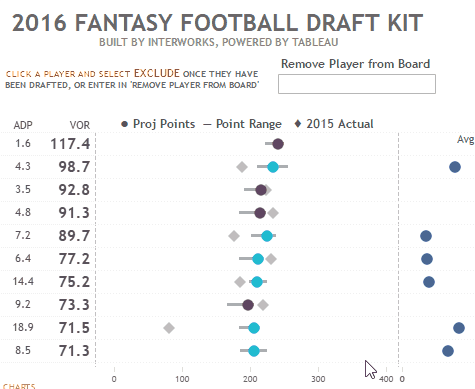August in America brings record temperatures and signals an end of six painful months without American Football. Sports news websites begin to surge in traffic; even ESPN, despite their broad coverage of global sports, gains significant ground in its Alexa rankings once Football is back.
As our new national pastime (sorry, baseball, but you knew) begins again, our need to compete with one another drives millions back to the slew of fantasy football providers. Though nearly every sport has fantasy leagues available, fantasy football reigns as supreme as football itself. It isn’t necessary for me to extol on the popularity of fantasy sports, so let’s just get right to the fun part: crushing your opponents, hearing the lamentations about their poor draft picks and claiming your league trophy!
This will be the third year I’ve built my fantasy football draft kit in Tableau. The first year (it wasn’t available publicly due to functionality issues on Tableau Server), I annihilated my regular season opponents. Last year, I was devastated by injuries but still had strong drafts. I’m sticking with my same data provider as last year because they aggregate projections from multiple sites instead of relying on a single “expert.” He’s even done advanced analysis on whether expert rankings or stat projections are more reliable as a predictor of fantasy success.
(Spoiler Alert: Stat projections win!)
How to Use This Kit
This Tableau dashboard is intended to be used while you are drafting your league(s). It was designed as simply as possible to interact with and display only the most important information.
The middle section, the draft list, represents the most important function of the dashboard. Here, you’ll see which player should be selected next based on Value Over Replacement. You can read more about VOR and see how to draft below.
The bottom-right chart shows how many players are available per position (non-DF/K) by point expectation buckets. This chart updates as you take players off the draft board and is helpful in visualizing the talent remaining in the draft pool at a glance.
The bottom-middle chart shows the top ten teams by total expected fantasy points for the year. This should help when trying to choose between players with similar VORs, as a team that is expected to score more points overall will probably spread points around better than a team that doesn’t score a lot of points (a rising tide lifts all boats). The position spread (bottom-left) and team list (bottom-middle) can both be clicked to filter the draft list.
By default, the draft list is sorted on the most important metric in intelligent draft strategies: Value over Replacement. Each player’s information (team, BYE, etc.), their VOR, expected range of points with consensus target and last year’s actual total points are displayed alongside the relative risk per player. You can find more information about the acronyms and logic below the dashboards if you aren’t already familiar.
Prior to drafting, I suggest reading this full post, including the acronyms below, playing with the dashboards a bit and then practice drafting with it. Every fantasy site offers “Mock Drafts” that suit this suggestion. That way, once your live draft starts, you’ll already be familiar with how to take players off the draft list, filter based on position or top teams and still keep up with the draft speed.
Personally, I’ll have a laptop with me when I draft both my leagues so that I can check player news and team depth charts (both are links when you click a player, position, or team). This helps me avoid drafting an injured or non-starting player. If you’re totally new to fantasy, it’s hard to go wrong with picking whoever is at the top of the draft list when your turn is up, except for your second quarterback can be a much later pick. It is also pretty safe to simply not draft a team defense or kicker. You will very rarely ever want more than one of either at any point in the season, and definitely not when you draft.
As each player is picked they need to be cleared from the draft list by clicking their name (or anything else on the row, circles/etc.) and clicking “Exclude” from the pop-up OR by typing a portion of their name in the “Remove Player from Board” box, hitting enter, then clicking the player.


Standard Scoring Tableau Fantasy Football Draft Kit
If you don’t know your league’s scoring system, use this version.
Points Per Reception (PPR) Tableau Fantasy Football Draft Kit
Metrics
Some of the terms you’ll need to be familiar with to use these kits, pulled from the VBR data source:
- Rank: Overall rank by VOR.
- POS: Position
- VOR: Value Over Typical Replacement Player. Used to rank players across positions. Calculated by comparing players’ projected points to a “typical” replacement player at the same position (determined by VOR baseline values). For more info on how VOR is calculated, see here.
- Points: Average projected points for a player across analysts.
- ECR Rank: Expert Consensus Ranking from FantasyPros.
- Pos Rank: Position rank.
- ADP: Average draft position.
- AAV: Average auction value.
- Risk: Risk of injury and degree of uncertainty of players’ projected points, calculated as the average of: 1) injury risk from Sports Injury Predictor and 2) the standard deviation of the players’ projected points and rankings across analysts. Standardized to have a mean of 5 and a standard deviation of 2 (higher values reflect greater risk).
ADP can help you identify if a player is going too early/late in your draft and is a great place to look for value later in the draft. If you’ve been diligently drafting by VOR and have a good team, but you still need an RB or WR on the bench, ADP can help you identify players that are available later than they should be. Your drafting site should be keeping track of what pick number your draft is at all times. If it’s the 100th pick and you see an ADP of 65 available, you should take a peek at that player’s news (linked when you click on a player in my draft kit) to see if there’s something going on with that player. Likewise, you’ll want to avoid drafting an ADP of 65 if it’s only the 20th pick.
Keep in mind that you’ll need to draft players in your website; any action you take on this Tableau dashboard won’t affect your actual draft. Additionally, you’ll want to try and keep up with draft pick filtering as players come off the board; otherwise, you’ll try to draft a player that isn’t available and spend time figuring out a replacement.

